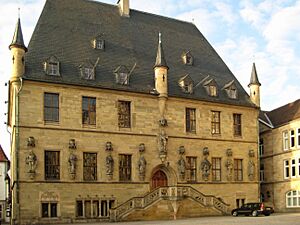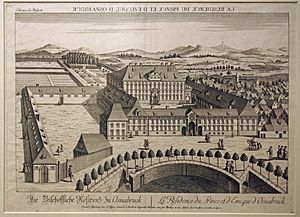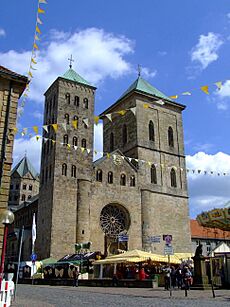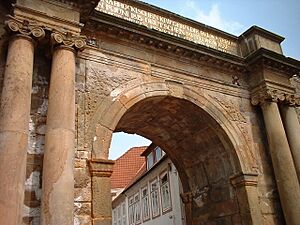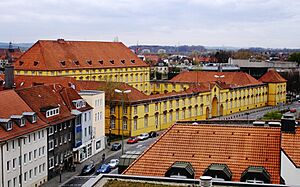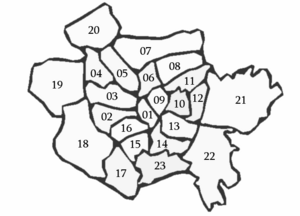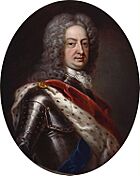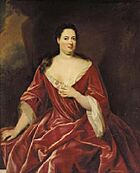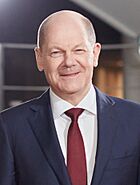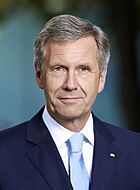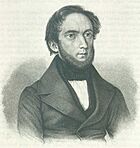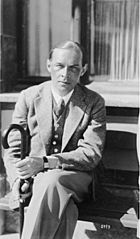Osnabrück facts for kids
Quick facts for kids
Osnabrück
Ossenbrügge (Westphalian)
|
|||
|---|---|---|---|
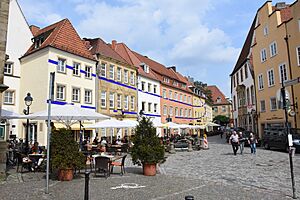
City centre of Osnabrück
|
|||
|
|||
| Country | Germany | ||
| State | Lower Saxony | ||
| District | Urban district | ||
| Elevation | 63 m (207 ft) | ||
| Population
(2022-12-31)
|
|||
| • City | 167,366 | ||
| • Metro | 272,674 | ||
| Time zone | CET/CEST (UTC+1/+2) | ||
| Postal codes |
49074–49090
|
||
| Dialling codes | 0541 | ||
| Vehicle registration | OS | ||
| Website | www.osnabrueck.de | ||
Osnabrück is a city in Lower Saxony, a state in western Germany. It sits in a valley between the Wiehen Hills and the northern part of the Teutoburg Forest, with the Hase river flowing through it. Osnabrück is the fourth largest city in Lower Saxony, with a population of over 168,000 people.
The city is known for its industries, including car manufacturing, paper, steel, and food companies. Even though Osnabrück was heavily damaged during World War II, its Altstadt (old town) has been rebuilt to look like its original medieval architecture. Osnabrück also has a lively student scene, with more than 22,000 students at the University and the University of Applied Sciences. While it's part of Lower Saxony, Osnabrück also has strong historical and cultural ties to the Westphalia region.
Contents
What's in a Name?
The exact meaning of the name Osnabrück is a bit of a mystery! The -brück part clearly means "bridge" (from the German word Brücke). But the Osna- part has a few ideas behind it.
One old idea is that it comes from Ossenbrügge, meaning "oxen bridge." However, this might not be true because the city is much older than this word change. Another idea is that it comes from the name of the Hase River, which might be linked to "Asen" (meaning Æsir, or gods). If this is true, then Osnabrück could mean "bridge to the gods."
The city also gave its name to a type of fabric called osnaburg.
A Look Back in Time
Medieval Times
Osnabrück started as a marketplace next to a special church area called a bishopric, which was set up by Charlemagne, the King of the Franks, in 780. It became the home of a Prince-Bishop (a leader who was both a religious and political ruler) before 803. Osnabrück is likely the oldest bishopric in Lower Saxony.
In 804, Charlemagne is said to have founded the Gymnasium Carolinum, which would make it Germany's oldest school of its kind. However, some historians debate if this date is correct.
In 889, the town was given special rights for trade, taxes, and making coins by King Arnulf of Carinthia. Osnabrück was first called a "city" in records in 1147. A few years later, Emperor Frederick Barbarossa allowed the city to build fortifications. Many of the old towers from these walls can still be seen today. Osnabrück joined the Hanseatic League (a powerful group of trading cities) in the 12th century.
Early Modern Age
Between 1561 and 1639, Osnabrück saw a lot of changes and disagreements. This was due to the Protestant Reformation (a big religious change), the Thirty Years' War (a major European conflict), and also a sad period of witch trials.
The first Lutheran church services happened in Osnabrück in 1543. Over time, more people became Lutheran. However, Catholic churches also continued to operate, and the city never became fully Lutheran.
Peace talks to end the Thirty Years' War took place in Osnabrück and the nearby city of Münster from 1643 to 1648. These talks led to the Peace of Westphalia, which officially ended the war. Osnabrück was then recognized as a city where both Catholics and Lutherans could live peacefully. The Prince-Bishop role would be held by a Catholic bishop and a Lutheran bishop, taking turns.
In the early 1700s, a famous local legal expert named Justus Möser wrote an important history of the town. After the Seven Years' War, the city's population dropped, but it grew again from the 1780s thanks to industries like linen and tobacco.
19th Century Changes
The French Revolutionary Wars brought Prussian troops to the city in 1795, followed by the French in 1803. Osnabrück changed hands several times during the time of Napoleon. It became part of the Kingdom of Hanover after 1815.
Osnabrück's first railway line was built in 1855. More train connections followed, linking the city to other major places. In 1866, Osnabrück became part of Prussia. The local economy and population grew a lot because of new engineering and textile factories. Electricity and modern sanitation also arrived in the late 1800s.
20th Century and Beyond
By 1914, Osnabrück had over 70,000 people. During the First World War, there were food shortages. After Germany's defeat in 1918, a new government called the Weimar Republic took over. Like many German cities, Osnabrück faced high inflation and unemployment in the 1920s.
In the 1930s, the Nazi Party gained a lot of support in the city. After the Nazis took power in 1933, Osnabrück saw economic growth for many, but people who disagreed with the new government and German Jews faced discrimination and hardship. During World War II, many Jews and Romani people were sent away to camps.
The war ended for Osnabrück on April 4, 1945, when British troops entered the city. By this time, much of the city had been bombed and needed a lot of rebuilding. After the war, Osnabrück became part of the new state of Lower Saxony in 1946.
The British military kept a large base near the city, known as Osnabrück Garrison, for many years. It was once the biggest British military base outside the United Kingdom. The troops left in 2008.
In 1974, Osnabrück finally got its own university, the University of Osnabrück.
Here are the largest groups of foreign residents in Osnabrück as of 2017:
| Rank | Nationality | Population (31 December 2017) |
|---|---|---|
| 1 | 2,725 | |
| 2 | 2,705 | |
| 3 | 2,025 | |
| 4 | 1,580 | |
| 5 | 1,030 |
Climate
Osnabrück has a climate with warm, rainy summers and cool, dark winters.
| Climate data for Osnabrück (1991–2020 normals) | |||||||||||||
|---|---|---|---|---|---|---|---|---|---|---|---|---|---|
| Month | Jan | Feb | Mar | Apr | May | Jun | Jul | Aug | Sep | Oct | Nov | Dec | Year |
| Mean daily maximum °C (°F) | 4.5 (40.1) |
5.6 (42.1) |
9.4 (48.9) |
14.4 (57.9) |
18.3 (64.9) |
21.2 (70.2) |
23.7 (74.7) |
23.3 (73.9) |
18.8 (65.8) |
13.8 (56.8) |
8.3 (46.9) |
4.8 (40.6) |
13.8 (56.8) |
| Daily mean °C (°F) | 1.0 (33.8) |
1.2 (34.2) |
4.9 (40.8) |
9.3 (48.7) |
13.2 (55.8) |
16.5 (61.7) |
18.8 (65.8) |
18.8 (65.8) |
14.6 (58.3) |
10.0 (50.0) |
5.5 (41.9) |
1.8 (35.2) |
9.9 (49.8) |
| Mean daily minimum °C (°F) | −0.3 (31.5) |
0.0 (32.0) |
2.2 (36.0) |
4.8 (40.6) |
8.3 (46.9) |
11.1 (52.0) |
13.6 (56.5) |
13.3 (55.9) |
10.2 (50.4) |
6.7 (44.1) |
3.4 (38.1) |
0.4 (32.7) |
6.2 (43.2) |
| Average precipitation mm (inches) | 83.3 (3.28) |
62.7 (2.47) |
66.6 (2.62) |
46.7 (1.84) |
62.8 (2.47) |
64.7 (2.55) |
85.3 (3.36) |
88.7 (3.49) |
73.2 (2.88) |
70.2 (2.76) |
78.2 (3.08) |
82.7 (3.26) |
885.1 (34.85) |
| Average precipitation days (≥ 1.0 mm) | 18.3 | 17.5 | 17.7 | 13.9 | 14.8 | 14.6 | 16.4 | 15.1 | 15.5 | 16.9 | 19.3 | 19.1 | 200.7 |
| Average relative humidity (%) | 85.3 | 83.0 | 78.1 | 70.5 | 71.3 | 71.9 | 72.5 | 74.3 | 81.3 | 84.7 | 87.5 | 87.9 | 79.0 |
| Mean monthly sunshine hours | 51.1 | 65.0 | 111.6 | 169.6 | 199.2 | 195.7 | 211.0 | 190.4 | 137.2 | 104.1 | 47.1 | 42.4 | 1,497.1 |
| Source: World Meteorological Organization | |||||||||||||
Cool Places to See
Osnabrück has many interesting places to visit:
- Town Hall: A historic building in the city center.
- St. Peter's Cathedral: Founded in the 11th century, it has two tall towers.
- Marienkirche: Another beautiful old church.
- Heger Tor ("Heger Gate"): A monument honoring soldiers from Osnabrück who fought in the Battle of Waterloo.
- Bucksturm: The oldest tower in the city, once part of the city walls. It was used as a prison a long time ago.
- Felix Nussbaum Haus: A museum and art gallery dedicated to the Jewish artist Felix Nussbaum. It was designed by famous architect Daniel Libeskind.
- Kalkriese Museum: Located on the battlefield of the Battle of the Teutoburg Forest, where German tribes defeated Roman legions. It shows artifacts found there.
- Osnabrücker Schloss (castle/palace): A 17th-century building that is now the main part of the University of Osnabrück.
- Botanischer Garten der Universität Osnabrück: The university's beautiful botanical garden.
- Old town: With its narrow streets and medieval buildings, it's great for exploring.
- Osnabrück Zoo: Home to many animals.
- Katharinenkirche (St. Catherine's Church): Dating back to 1248, it's one of the tallest medieval buildings in Lower Saxony.
- Hyde Park: A traditional music hall that has been a center for pop music and youth culture since 1976.
Learning and Schools
Osnabrück is a great place for students! It has two main higher education places: the University of Osnabrück and the Osnabrück University of Applied Sciences. Together, they have over 25,000 students.
The city also has many types of schools, including seven Gymnasien (schools that prepare students for university). The Gymnasium Carolinum claims to be the oldest school still running in Germany.
Sports Teams
Osnabrück has a football (soccer) team called VfL Osnabrück, which was started in 1899. They currently play in the 2. Bundesliga, one of Germany's top leagues. The city also has a basketball team, VfL Osnabrück's basketball team, founded in the same year.
The Schlosswallhalle is home to the GiroLive Panthers Osnabrück, a women's basketball team that plays in Germany's top league.
Getting Around
Osnabrück is well-connected by major roads like the A1, A30, and A33.
The city shares its airport with the nearby city of Münster.
Osnabrück Hauptbahnhof (the central train station) is an important place for train travel. Many travelers from the Netherlands going to places like Hamburg or Denmark often change trains here.
Inside the city, there's a big bus network run by the local public service provider. The main bus stop is at Neumarkt, close to the shopping street.
City Areas
Osnabrück is divided into 23 different areas, or districts:
|
|
|
Friendship Cities
Osnabrück has "twin town" or "sister city" agreements with many cities around the world. This means they have special friendships and often exchange visits and ideas.
 Haarlem, Netherlands (1961)
Haarlem, Netherlands (1961) Angers, France (1964)
Angers, France (1964) Gmünd, Austria (1971)
Gmünd, Austria (1971) Derby, United Kingdom (1976)
Derby, United Kingdom (1976) Greifswald, Germany (1988)
Greifswald, Germany (1988) Tver, Russia (1991)
Tver, Russia (1991) Evansville, United States (1991)
Evansville, United States (1991) Gwangmyeong, South Korea (1997)
Gwangmyeong, South Korea (1997) Çanakkale, Turkey (2004)
Çanakkale, Turkey (2004) Vila Real, Portugal (2005)
Vila Real, Portugal (2005) Hefei, China (2006)
Hefei, China (2006)
Special Friendship with Derby
Osnabrück wanted to find a British twin town as early as 1948 to build better understanding after World War II. They finally signed an agreement with Derby, United Kingdom, on February 17, 1976. Since then, the two cities have exchanged visitors every year. Derby even has a square named after Osnabrück to celebrate this friendship.
Famous People from Osnabrück
Many notable people have come from Osnabrück:
Public Service and Thinkers
- Benno II of Osnabrück (c. 1020–1088): A bishop of Osnabrück.
- Justus Möser (1720–1794): A lawyer and thinker who wrote about the town's history.
- Ludwig Windthorst (1812–1891): An important politician.
- Hans Georg Calmeyer (1903–1972): A lawyer honored for helping people during a difficult time.
- Olaf Scholz (born 1958): A politician who became the Chancellor of Germany in 2021.
- Christian Wulff (born 1959): A politician who served as President of Germany from 2010 to 2012.
- Boris Pistorius (born 1960): A politician who was the mayor of Osnabrück and is now the Minister of Defence.
Artists and Performers
- Gerlach Flicke (c. 1500–1558): A painter who worked for the Tudor court in London.
- Friedrich Clemens Gerke (1801–1888): A journalist and musician who helped improve the Morse code.
- Erich Maria Remarque (1898–1970): A famous novelist who wrote All Quiet on the Western Front.
- Felix Nussbaum (1904–1944): A surrealist painter.
- Gentleman (born 1974): A well-known reggae musician.
- Robin Schulz (born 1987): A popular musician, DJ, and record producer.
Science and Business
- Hermann Kemper (1892–1977): An engineer who was a pioneer in magnetic levitation (maglev) technology.
- Wilhelm Karmann Jr. (1914–1998): A successful entrepreneur in the car industry, known for his work with VW.
Sports Stars
- Horst Borcherding (1930–2015): A football goalkeeper.
- Heike Nagel (born 1946): A former swimmer who won a bronze medal at the 1968 Summer Olympics.
- Thomas Möllenkamp (born 1961): A retired rower who won a gold medal at the 1988 Summer Olympics.
- Volker Fried (born 1961): A former field hockey player who won a gold medal at the 1992 Summer Olympics.
- Stefani Werremeier (born 1968): A rower who won a silver medal at the 1992 Summer Olympics.
- Carolin Schnarre (born 1992): A Paralympic equestrian who won a silver medal at the 2016 Paralympic Games.
See also
 In Spanish: Osnabrück para niños
In Spanish: Osnabrück para niños




